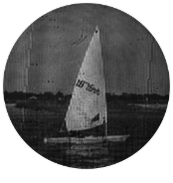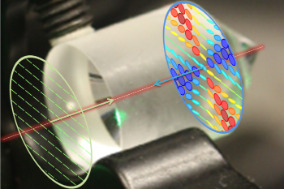Phase and polarisation patterns
Shaping light beams
 Light allows us to sense the world around us, and has been used as a tool for hundreds of years. Fixed optical components such as lenses and prisms allow a wide range of control however current technology allows an unprecedented control of the full optical field. Spatial light modulators (SLMs) and digital micromirror devices (DMD) allow us to dial up any optical field we desire, through the use of digital holograms. We routinely create shaped optical fields for generation of orbital angular momentum, or bespoke patterns for our atom optics work. There are numerous methods for beam shaping in the literature and we have tested a set of these methods, both experimentally and analytically. For more info see Optics Express 24, 6, 6249-6264 (2016) and Journal of Optics (2017).
Light allows us to sense the world around us, and has been used as a tool for hundreds of years. Fixed optical components such as lenses and prisms allow a wide range of control however current technology allows an unprecedented control of the full optical field. Spatial light modulators (SLMs) and digital micromirror devices (DMD) allow us to dial up any optical field we desire, through the use of digital holograms. We routinely create shaped optical fields for generation of orbital angular momentum, or bespoke patterns for our atom optics work. There are numerous methods for beam shaping in the literature and we have tested a set of these methods, both experimentally and analytically. For more info see Optics Express 24, 6, 6249-6264 (2016) and Journal of Optics (2017).
Polarisation shaping
Polarisastion is an invisible property of light, which has been harnessed in everyday applications, from increasing broadband speeds to driving the technology behind 3D movies. The polarisation of a light beam has traditionally been the same at each position of a light beam, however we are developing extension of our beam shaping techniques which allow manipulation of polarisation at each position within the beam. This control allows the generation of a vast new array of optical fields, which have capabilities beyond what is possible with uniform polarisation. For instance, a beam shaped such that the polarisation direction always points outwards from the beam centre will focus to a tighter spot than a conventional beam, which enables more precise laser machining or microscopes which can see finer detail.
For recent developments see Optics Express, 24, 25, 29269-29282, (2016).
Broad-band vector vortex beams
Vector vortex beams have structured polarisation and contain orbital angular momentum (OAM). This allows these beams to outperform conventional beams in a range of applications such as optical machining and microscopy. Typically, the precise optical control required to generate these beams has limited their generation to single wavelengths, limiting their effectiveness in applications requiring white light or short pulses. We have recently been developing a new technique which allows broad-band generation of vector vortex beams from a passive glass element - a Fresnel cone. These devices are capable of generating broad-band, high power vector vortex beams with a simple drop-in element which is cost-effective. We carry out this work as part of a QuantIC partnership resource project in collaboration with Gooch and Housego.
Details can be found in Nature Communications 7, 10564 (2016).



